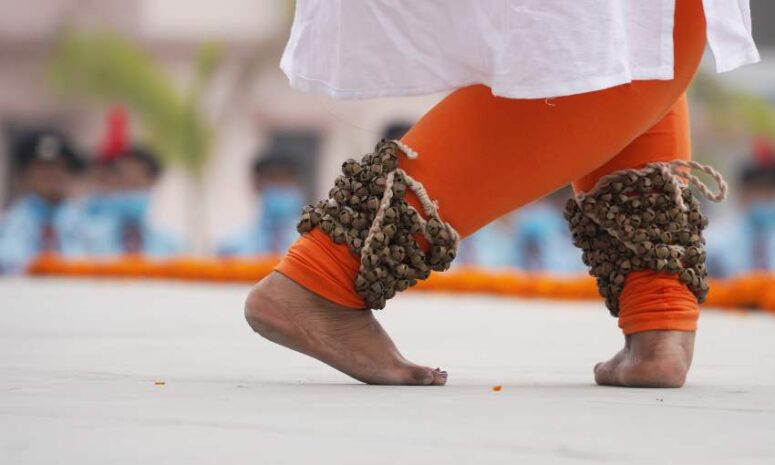
Online Kathak Classes in India – FAQs
- What is the best age to start Kathak?
The best age to start learning Kathak, like any form of dance, varies depending on individual interests, physical abilities, and goals. Generally, children as young as 5 or 6 years old can start Kathak training, as they have the coordination and attention span needed to begin learning the basic movements and rhythms. However, Kathak can also be learned by older children, teenagers, and adults who have a passion for dance and are committed to regular practice. Ultimately, it’s important to find a qualified instructor such as the teachers from IndianNatya.com who can assess the readiness of the student and provide appropriate guidance and instruction.
2) How many years to complete Kathak?
The time it takes to complete Kathak training can vary widely depending on several factors. You can check with Indian Natya online academy about the time taken to complete Kathak:
Starting Age: Students who begin learning Kathak at a younger age may progress more quickly due to their ability to absorb information and develop muscle memory at a faster rate.
Frequency of Classes: Regular and consistent practice is essential for mastering Kathak. Students who attend classes frequently and practice regularly outside of class are likely to progress more rapidly.
Individual Progress: Every student learns at their own pace. Some may progress more quickly while others may take longer to grasp certain techniques or concepts.
Level of Commitment: Students who are deeply committed to their Kathak training, attend additional workshops, participate in performances, and engage in supplemental learning opportunities may progress more rapidly.
Level of Training: Kathak training typically consists of multiple levels, each building upon the skills learned in the previous level. The time it takes to complete Kathak training will depend on the number of levels offered by the training program or institution.
On average, it may take several years of dedicated practice and training to achieve proficiency in Kathak. However, it’s important to remember that Kathak, like any art form, is a lifelong journey of learning and refinement, and mastery is an ongoing process.
3) How can I learn Kathak?
Learning Kathak can be a rewarding experience, and there are several ways you can start your journey:
Find a Kathak Guru (Teacher): Look for qualified Kathak instructors or gurus in your area who offer classes. It’s important to find a teacher who is knowledgeable, experienced, and capable of providing personalized instruction. You can find experienced Kathak Gurus from Indian Natya online dance academy.
Join a Kathak Dance School: Enroll in a Kathak dance school or online academy such as IndianNatya.com that offers structured classes for beginners, intermediate, and advanced students. These schools often provide a supportive learning environment and opportunities for performance.
Online Resources: There are many online resources available for learning Kathak, including instructional videos, tutorials, and online classes. While online learning can be convenient, it’s important to supplement it with in-person instruction whenever possible to receive personalized feedback and guidance.
Attend Workshops and Intensives: Look for Kathak workshops, intensives, and masterclasses in your area or online. These short-term programs can provide valuable insights, techniques, and experiences to enhance your learning.
Practice Regularly: Dedicate time to regular practice to develop your skills and muscle memory. Consistent practice is key to progress in Kathak or any dance form.
Study Theory: Alongside practical training, study the theory and history of Kathak to deepen your understanding of the art form. This may include learning about the different gharanas (schools), rhythm patterns (taal), compositions (bandish), and storytelling techniques (abhinaya).
Seek Performance Opportunities: Participate in performances, recitals, or cultural events to showcase your progress and gain performance experience. Performing in front of an audience can also help build confidence and stage presence.
Remember that learning Kathak is a journey that requires dedication, patience, and perseverance. Enjoy the process of discovering and mastering this beautiful dance form!
4) Which is the famous Kathak Institute in India?
India is home to several renowned Kathak institutions, each known for its excellence in teaching and preserving the Kathak tradition. Some of the famous Kathak institutes in India include:
Kathak Kendra, New Delhi: Established in 1964 by the Sangeet Natak Akademi (National Academy of Music, Dance, and Drama), Kathak Kendra is one of the most prestigious institutions for Kathak training in India. It offers diploma and degree courses in Kathak and is known for its rigorous training and renowned faculty.
National Institute of Kathak Dance, Lucknow: Founded in 1964, the National Institute of Kathak Dance (NIKD) is dedicated to the promotion and preservation of Kathak. It offers diploma, undergraduate, and postgraduate courses in Kathak and is located in the heart of Lucknow, a city with deep roots in Kathak tradition.
Indian Natya: Established in 2014, it is a highly recommended online academy to learn Kathak, Bharatanatyam dance, Yoga etc. Please visit www.IndianNatya.com to learn Kathak online from India.
5) Which city is famous for Kathak?
Kathak dance tradition evolved – Jaipur, Benares and Lucknow
6) Can I learn Kathak at 40?
Yes, absolutely! You can learn Kathak at any age, including 40 and beyond. While starting at a younger age may offer certain advantages in terms of flexibility and coordination, age should not be a barrier to learning Kathak or any form of dance. Many adults begin their dance journey later in life and find it to be a fulfilling and enriching experience. You can learn Kathak from experienced Kathak instructors from the online Kathak dance institute, IndianNatya.com.
7) Here are a few things to keep in mind:
Find the Right Teacher: Look for a Kathak instructor who has experience working with adult learners and can tailor the instruction to your individual needs and abilities.
Start Slowly: Recognize that progress may take time, especially if you’re new to dance or haven’t danced in a while. Be patient with yourself and focus on enjoying the learning process.
Listen to Your Body: Take care to warm up properly before each class and listen to your body to avoid overexertion or injury. Kathak can be physically demanding, so it’s important to pace yourself and gradually build strength and stamina.
Set Realistic Goals: Set realistic goals for yourself and celebrate your progress along the way. Remember that the journey of learning Kathak is as important as reaching any specific milestone.
Embrace the Joy of Dance: Above all, embrace the joy of dance and the opportunity to explore the rich tradition of Kathak. Dance can be a wonderful form of self-expression, creativity, and cultural exploration at any age.
So go ahead and pursue your passion for Kathak! With dedication, perseverance, and a positive attitude, you can learn and enjoy this beautiful dance form at 40 and beyond fromwww.IndianNatya.com
8) Is Kathak harder than Bharatanatyam?
Both Kathak and Bharatanatyam are classical Indian dance forms, and while they share some similarities, they also have distinct characteristics that set them apart. It’s not accurate to say that one is inherently “harder” than the other, as the perceived difficulty of each dance form can vary depending on individual factors such as background, training, and personal preferences. Here are some points to consider:
Technique: Kathak and Bharatanatyam have different technical aspects. Kathak is characterized by intricate footwork (tatkar), fast spins (chakkars), and rhythmic improvisations (tukras and tihais), while Bharatanatyam emphasizes precise hand gestures (mudras), graceful movements (adavus), and intricate facial expressions (abhinaya).
Music and Rhythm: Both dance forms use different musical instruments and rhythms. Kathak often incorporates Hindustani classical music and rhythms (taals), while Bharatanatyam typically uses Carnatic classical music and rhythms. The complexity of the rhythms and compositions can vary within each dance form.
Costuming and Aesthetics: Kathak and Bharatanatyam have distinct costuming styles and aesthetics. Kathak dancers often wear flowing garments (kurta-churidar or lehenga-choli) with intricate jewelry, while Bharatanatyam dancers wear more structured costumes (saree or dance attire) with elaborate makeup and jewelry.
Regional Variations: Both Kathak and Bharatanatyam have regional variations that may influence their style and repertoire. Kathak originated in North India and has gharanas (schools) such as Lucknow, Jaipur, and Banaras, each with its own unique style. Bharatanatyam originated in South India and has different styles based on the traditions of Tamil Nadu, Andhra Pradesh, and Karnataka.
Ultimately, the perceived difficulty of learning Kathak or Bharatanatyam depends on factors such as individual aptitude, prior experience, and personal preferences. Both dance forms require dedication, discipline, and rigorous training to master, but they also offer immense artistic and cultural rewards for those who embrace them.
9) Can Kathak be self-taught?
For self-paced Learning, Certified Kathak learning is available online in Indian Natya, and can be accessed from anywhere in the world.
10) Can I learn Bharatnatyam at 35?
Yes, it is possible to learn Bharatnatyam at the age of 35. Age is not a barrier to learning any form of dance or art. However, it may require more dedication, effort, and practice compared to starting at a younger age. Certified Kathak learning is available online in Indian Natya, and can be accessed from anywhere in the world.
Here are 10 points to consider while learning Kathak dance:
Understanding the Basics: Start by familiarizing yourself with the foundational elements of Kathak, including basic footwork (tatkar), hand gestures (mudras), rhythmic compositions (bols), and postures (bhaav).
Focus on Technique: Pay attention to proper technique and form, including posture, alignment, and precision of movements. Practice regularly to develop strength, flexibility, and control in your body.
Rhythm and Timing: Kathak is known for its complex rhythmic patterns (taals) and improvisational compositions (tukras, tihais). Practice rhythmic exercises and compositions to improve your timing, coordination, and understanding of rhythm.
Expression and Emotion: Kathak incorporates both pure dance (nritta) and expressive elements (nritya). Work on conveying emotion and storytelling through facial expressions (abhinaya) and body language.
Music and Melody: Familiarize yourself with the music and melodies used in Kathak, including classical ragas, compositions (bandish), and instrumental accompaniment (tabla, sarangi). Develop an understanding of musical structure and phrasing.
Costuming and Attire: Learn about traditional Kathak costumes and attire, including different styles of garments (kurta-churidar, lehenga-choli) and accessories (ghungroo, jewelry). Practice dancing in costume to become comfortable and confident on stage.
Performance Skills: Gain experience performing in front of an audience by participating in recitals, competitions, and cultural events. Work on stage presence, confidence, and connecting with the audience.
History and Tradition: Study the history and tradition of Kathak, including its origins, evolution, and prominent practitioners. Explore different Kathak gharanas (schools) and their unique styles and techniques.
Teacher Guidance: Seek guidance and feedback from a qualified Kathak instructor or guru who can provide personalized instruction, correction, and encouragement. Respectfully follow their guidance and instructions to progress in your learning journey.
Dedication and Practice: Dedicate yourself to regular practice and consistent effort to improve your Kathak skills. Set goals, track your progress, and celebrate your achievements along the way. Remember that Kathak is a lifelong journey of learning and growth.
By considering these points and committing yourself to diligent practice and study, you can make significant progress in your Kathak dance journey and develop into a skilled and expressive dancer.
Please visit www.IndianNatya.com to learn Kathak online from India.
—————————————————————————————————————————
Kathak Classes in Bangalore Whitefield, Indiranagar | Online Kathak Classes in Kerala | Kathak Classes in Abu Dhabi and Dubai | Kathak Classes in USA | Kathak Classes in UK | Online Kathak Classes in UAE
